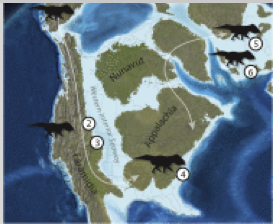A ceratopsian dinosaur from the Late Cretaceous of eastern North America, and implications for dinosaur biogeography
Author:
Longrich
Abstract:
Tyrannosaurs and hadrosaurs from the Late Cretaceous of eastern North America (Appalachia) are distinct from those found in western North America (Laramidia), suggesting that eastern North America was isolated during the Late Cretaceous. However, the Late Cretaceous fauna of Appalachia remains poorly known. Here, a partial maxilla from the Campanian Tar Heel Formation (Black Creek Group) of North Carolina is shown to represent the first ceratopsian from the Late Cretaceous of eastern North America. The specimen has short alveolar slots, a ventrally projected toothrow, a long dentigerous process overlapped by the ectopterygoid, and a toothrow that curves laterally, a combination of characters unique to the Leptoceratopsidae. The maxilla has a uniquely long, slender and downcurved posterior dentigerous process, suggesting a specialized feeding strategy. The presence of a highly specialized ceratopsian in eastern North America supports the hypothesis that Appalachia underwent an extended period of isolation during the Late Cretaceous, leading the evolution of a distinct dinosaur fauna dominated by basal tyrannosauroids, basal hadrosaurs, ornithimimosaurs, nodosaurs, and leptoceratopsids. Appalachian vertebrate communities are most similar to those of Laramidia. However some taxa-including leptoceratopsids-are also shared with western Europe, raising the possibility of a Late Cretaceous dispersal route connecting Appalachia and Europe.
Monday, September 14, 2015
A new Leptoceratopsid Ceratopsian From Campanian Cretaceous Appalachia
Labels:
appalachia,
campanian,
ceratopsians,
cretaceous,
dinosaurs,
fossils,
Leptoceratopsid,
mesozoic,
nonavian dinosaurs,
North america,
paleontology
Subscribe to:
Post Comments (Atom)

No comments:
Post a Comment